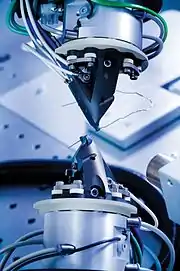SureSmile
SureSmile is a type of customized orthodontic arch wires used by orthodontists to straighten teeth. The technique utilises 3-D imaging, treatment planning software and a robot to create the wires. The technique is reported in World Journal of Orthodontics to decrease the time required to complete orthodontic treatment by 34% and increase the precision of the results.[1]

Design
The orthodontists uses digital images of a patient's mouth and teeth using either a white light scanner or cone beam computed tomography (CBCT). The software tools the orthodontist takes the teeth and individually aligns them into the proper position.[2]
Once the orthodontist has virtually designed the smile and bite, SureSmile software plans the most efficient and direct route for moving teeth into the proper place and sends this information to a robot that bends and shapes the wires specifically for that patient. The wire with all of the custom bends is then sent back to the orthodontist ready to place on the patient.
Innovations
- The treatment time is faster.[3] While a tooth will move at the same rate regardless of the method used, the SureSmile system moves a tooth to its target position in the most efficient path due to the software’s ability to calculate concurrent tooth movements and the robot’s ability to bend the wire precisely to generate the prescribed movement.
- The patient only has 1-2 wire changes compared to many wire changes and/or adjustments with conventional braces. Unlike conventional treatment where the orthodontist manually bends a series of straight wires using pliers to move the teeth one-by-one into position, with SureSmile all the bends to move teeth are made in a niti (nickel titanium) shape-memory wire and when it is placed into the patient’s mouth—their body temperature activates those permanent bends to move teeth directly into place. The end result has a more precise result.
- SureSmile produces more precise results than traditional braces because of the software planning and the robot. Dr. Sammy Thabet of Germantown, MD, explains on CNN Health Minute with Sanjay Gupta, MD, "The [treatment planning software] is accurate to 1/10th of a millimeter. The robots are able to reproduce the accuracy with the wires, and that is something I cannot do by hand."[4]
- The initial scan is accurate to within 50 µm, and linear error is minimized to less than 0.1 mm per tooth. The creation of the archwires is accurate to within 1 mm, and 1˚. The bracket placement is accurate to within 25 µm, and in vivo bracket placement is accurate to within 1 mm.
Outcome quality
| Study | Sample Size | Treatment Time | SureSmile Treatment Efficiency |
SureSmile Quality Improvement |
|---|---|---|---|---|
| Saxe et al. (ORTHODONTICS), 2010 University of Las Vegas[5] | SureSmile: 38 Conventional: 24 Doctors: 3 | SureSmile: 14.7 months Conventional: 20 months | 25% less (6 months) | 14.3% better |
| Alford et al. (Angle), 2011 Indiana University [6] | SureSmile: 69 Conventional: 63 Doctors: 1 | SureSmile: 15.8 months Conventional: 23 months | 31% less (7.2 months) | 11% better |
Note: Both studies used consecutively treated, non-extraction cases.
Lingual braces
SureSmile has a lingual or behind teeth braces option called SureSmile QT.With lingual braces, brackets are adhered to the underside of the teeth on the top arch, bottom arch or both arches. Most patients choose lingual braces for aesthetic reasons, as they cannot be seen. Orthodontists that offer lingual braces will often suggest putting lingual braces on the upper teeth and clear ceramic braces on the bottom though patients can choose to have lingual braces on both arches. A news segment on WGN-TV Medical Watch recently featured SureSmile QT and explains that the same SureSmile robotic technology is used for the behind teeth braces.[7]
History
The SureSmile technology was developed and is owned by OraMetrix, a company founded in 1998 by Friedrich (Fritz) Riemeier [8] and Dr. Rohit Sachdeva,[9] through the merger of two medical technology companies, one U.S. based and the other German. The company was launched globally in 1999 with the help of a $150,000 investment from STARTech Early Ventures LLC. Other key investors include Brentwood Venture Capital, CenterPoint Ventures, Rho Ventures and STAR Ventures.
The SureSmile System received 510K marketing clearance from the U.S. Food and Drug Administration (FDA) in November 2000. In 2003, OraMetrix relocated its U.S. corporate headquarters from Dallas to a larger, 25,000-square-foot facility in Richardson, Texas.
References
- Saxe, A. K.; Louie, L. J.; Mah, J. (2010). "Efficiency and effectiveness of SureSmile". World Journal of Orthodontics. 11 (1): 16–22. PMID 20209172.
- "Robotic Braces". The Science Channel. Brink. Retrieved January 8, 2009.
- Alford, Timothy J.; W. Eugene Roberts; James K. Hartsfield Jr; George J. Eckert; Ronald J. Snyder (January 24, 2011). "Clinical outcomes for patients finished with the SureSmile Method Compared with Conventional Fixed Orthodontic Therapy". Angle Orthodontist. 81 (3): 383–388. doi:10.2319/071810-413.1. PMC 5161459. PMID 21261488.
- Gupta, Sanjay. CNN Health Minute http://edition.cnn.com/video/#/video/health/2010/05/17/gupta.robotic.braces.cnn. Retrieved May 17, 2010. Missing or empty
|title=(help) - Saxe, A. K.; Louie, L. J.; Mah, J. (2010). "Efficiency and effectiveness of SureSmile". World Journal of Orthodontics. 11 (1): 16–22. PMID 20209172.
- Alford, Timothy J.; W. Eugene Roberts; James K. Hartsfield Jr; George J. Eckert; Ronald J. Snyder (January 24, 2011). "Clinical outcomes for patients finished with the SureSmile Method Compared with Conventional Fixed Orthodontic Therapy". Angle Orthodontist. 81 (3): 383–388. doi:10.2319/071810-413.1. PMC 5161459. PMID 21261488.
- Bair, Dina. "A Hidden Way to Correct Teeth". WGN Medical Watch. Retrieved May 25, 2011.
- https://www.suresmile.com/about-orametrix/management/#riemeier
- https://www.bloomberg.com/research/stocks/private/person.asp?personId=607010&privcapId=136201&previousCapId=136201&previousTitle=OraMetrix,%2520Inc.